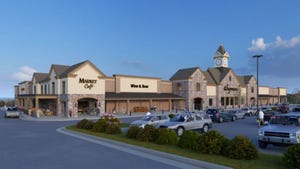Grocery store sales grow less in September
Pace of core retail sales gains is slowing down, the National Retail Federation’s chief economist reported.

Growth in grocery store sales tailed off in September, rising less than overall U.S. retail sales and reflecting the impact of a further relaxation in food price inflation.
For September, retail and foodservice sales edged up 0.7% to $704.88 billion (seasonally adjusted) from $699.88 billion in revised data for August and gained 3.8% from updated figures for September 2022, the U.S. Census Bureau reported in advance estimates on Tuesday.
Retail trade sales—excluding motor vehicles, parts stores, gas stations and repair shops—posted the same monthly increase but a bigger annual gain, up by 0.7% sequentially to $613.02 billion (seasonally adjusted) and by 3% over 12 months.
The September results compared with upward-revised increases of 0.8% monthly and 2.9% annually for August retail and foodservice sales and 0.8% monthly and 2.1% year over year for August retail trade sales.
Grocery retail sales advanced 0.4% to $74.19 billion (seasonally adjusted) in September from $73.92 billion in upward-revised numbers for August, when sales also were up 0.4% sequentially, according to the Census Bureau. September grocery store sales rose 1.6% from a year ago, less than the 2% increase for August.
Sales at all food and beverage stores in September mirrored the growth in grocery, up 0.4% monthly to $82.53 billion from an updated $82.22 billion in August and gaining 1.6% over 12 months. The Census Bureau’s downward-adjusted data for August showed gains of 0.3% month to month and 1.9% year over year for the retail segment.

From U.S. Census Bureau
Inflation letup provides consumer respite
“September’s retail sales were considerably stronger than expected, with broad-based gains across most categories. Price relief from softer core inflation is helping to blunt the negative impact of elevated gas prices and interest rates on spending, with consumers reporting less sticker shock in September,” Kayla Bruun, economic analyst at data intelligence firm Morning Consult, said in an email on Tuesday.
Last week, the U.S. Bureau of Labor Statistics reported that the September Consumer Price Index rose 3.7% (unadjusted) year over year, the same as in August. That ended two months of yearly increases in inflation after 12 months of annual declines in the CPI. On a monthly basis, the September CPI increased 0.4% (seasonally adjusted), down from a 0.6% gain in August. Food-at-home prices inched up 0.1% monthly and 2.4% annually for September, down from 0.2% monthly and 3% annually for August.
“Morning Consult’s data suggests consumers’ appetite for nonessential spending may be cooling off along with the weather, with U.S. households increasingly focusing on shoring up finances and paying off debts,” Bruun added.
Shoppers hold ‘plenty of buying power’
On Tuesday, the National Retail Federation (NRF) reported U.S. retail sales up 0.5% monthly (seasonally adjusted) in September, higher than an upward-revised 0.2% sequential increase in August. Year over year, total retail sales grew 2.2% (unadjusted) for September versus an upward-revised 3.6% gain in August, NRF said.
NRF’s estimate focuses on core retail, excluding automobile dealers, gas stations and restaurants. The retail trade group noted that its September figures rose by 3.1% unadjusted year over year on a three-month moving average and by 3.7% for the first nine months of the year.
“The consumer is still healthy, and today’s report shows households are forging ahead with plenty of buying power despite persistent inflation, rising interest rates and geopolitical conflicts,” NRF Chief Economist Jack Kleinhenz stated. “Firm payroll growth over the past few months has likely helped spending across retail sectors. However, much of the rise was due to car sales, gasoline prices and food services. When you exclude those categories and look at core retail as measured by NRF, the pace of year-over-year growth is slowing.”

The National Retail Federation pegged September grocery and beverage retail sales growth as up 0.4% monthly and 2.1% over 12 months. / Photo: Shutterstock
As in the previous month, five of nine retail categories tracked by NRF recorded 12-month sales gains in September, including grocery and beverage stores, health and personal care stores (including drug stores), general merchandise stores, online stores, and apparel and accessories stores, with increases ranging between 0.8% and 7.3%. Sales declined on an annual basis at sporting goods stores, electronics and appliance stores, building materials and garden supply stores, and furniture and home furnishing stores, with decreases running 1.6% to 6.5%.
On a monthly basis, September retail sales rose in four segments: grocery and beverage stores, health and personal care stores (including drug stores), general merchandise stores and online stores, with gains of 0.4% to 1.1%. Sequential sales were flat for sporting goods stores and furniture and home furnishings stores but declined for electronics and appliance stores (-0.8%) and building materials and garden supply stories (-0.2%).
Grocery and beverage store sales ticked up 0.4% month to month seasonally adjusted in September and 2.1% unadjusted annually, NRF said. Among other retail categories in the food, drug and mass channel, September sales grew 0.8% month over month seasonally adjusted and climbed 7.3% unadjusted year over year for health and personal care stores (including drug stores), and general merchandise stores saw increases of 0.4% month over month seasonally adjusted and a 3% unadjusted year over year.
“September retail sales show that consumers have retained the ability and willingness to spend despite accumulating economic headwinds from higher interest rates and slowing growth,” according to NRF President and CEO Matthew Shay. “As we gear up for the holiday season, we expect moderate growth to continue as consumers focus on value and household priorities. Retailers have been hard at work getting holiday inventories in place to provide consumers with great products, competitive prices and convenience at every opportunity.”
About the Author
You May Also Like






